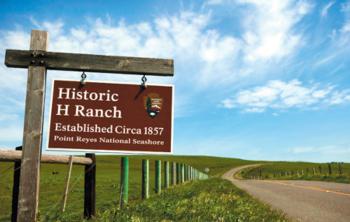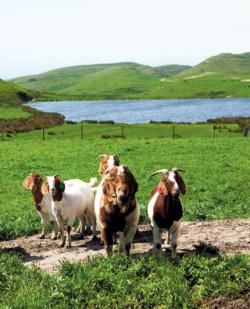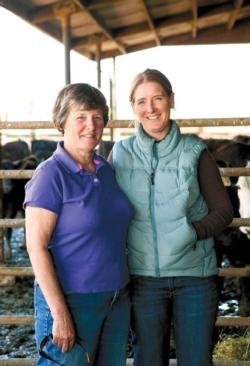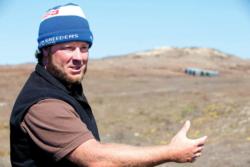Working from the heart: The legacy of a Point Reyes farming family
By Beth Kirsten Jones Neff
Edible Marin & Wine Country
08/2011


Dolores Evans grew up on the H Ranch and then raised her own two children, David Evans and Julie Evans Rossotti, on the ranch. Both Julie and David are now fourth generation Point Reyes farmers. When I arrive, Julie, a bright-eyed woman in her mid-30s, greets me at the gate. Julie and her husband Tony Rossotti own and operate Rossotti Ranch in Petaluma, but they keep a portion of their herd of grass-fed African Boer goats on the certified organic acreage of Julie’s childhood home. “I’m sorry my mom’s going to be a little late for the interview,” Julie apologizes, pointing south toward the barn and a maze of paddocks. Over the dark heads of several dozen cattle I see Dolores, shouting and herding her charges. “She wants to get the vaccinations done before she has her other shoulder replaced next month.” “Her other shoulder?” I think to myself. “She’s really only got one good arm right now,” Julie tells me as I stare with admiration at her mother’s strength and dexterity.
When Dolores finally takes a lunch break, we sit on a warm, wind-protected bench to talk about the cow and calf operation she and her husband, Dan, who grew up in nearby Marshall, CA, have run for 35 years. Looking out over the land she knows like the back of her hand, she reminisces about growing up on the peninsula before it became a national park. As close as they were to large population centers, hers was an adventurous childhood, with very few restrictions. Her family harvested their own protein and fiber, hunting and tending a robust vegetable garden. “I’d follow my father around and he’d teach me to do everything,” Dolores says. “We’d hunt. Everything you shot—you were taught to use it.” Her father was Alfred Grossi, a son of Domenico and Teresa (nee Buzzini) Grossi, who first arrived in West Marin in the late 1800s. Alfred and his wife, Florence, inherited H Ranch from Domenico and Teresa, and ran it as a dairy before Dolores and Dan took over and transitioned to beef cattle in the 1970s.
In 1962, President Kennedy had signed a bill creating the Point Reyes National Seashore, encompassing the H Ranch and others in the area. The federal government’s stated mission was to protect the peninsula from development, but what would happen to the families who owned the land? How would they be compensated for the land, not to mention the loss of livelihood for those who made their living by ranching? Over the next decade, various deals were negotiated with the ranch owners in which the government bought their land and then leased it back to the former owners as long as they agreed to preserve it as “pastoral” working farmland.

Dolores, now in her 60s, with a bad shoulder and a bum knee, still seems to have more energy and stamina than many 40 year olds. She is a living reminder that producing food is hard work. She is also one of the fortunate people on this planet who love their home and vocation, including the job requirements that have her hauling and tossing hay bales— the unfortunate undoing of her shoulders. As she speaks, she gazes out toward her cattle—on her lunch break, but always observing. The current H Ranch cow and calf operation involves about 300 head of cattle, an innovative cross of Angus, Herefords and Gelbviehs. As her daughter says, Dolores “knows every single one by its face,” tending them as if they were children, monitoring their health by the look in their eyes and the texture of their coat. “I watch,” Dolores tells me in her concise, matter-of-fact way. “I am always watching.”
Both Julie and her brother David, who raises cows, sheep, goats and chickens for his own company, Marin Sun Farms, located just over a southern ridge adjacent to H Ranch, credit their parents for teaching them to tend their livestock with utmost care. “Sustainable” and “cruelty-free,” now trendy terms of art, have been the staples of their family’s farming ethos. This is a hands-on practice, a farm of people tending animals and a far cry from mechanized corporate agriculture. Dolores and Dan Evans do everything from tractor repair to vaccinations themselves, with the help of only one “excellent” long-term employee.
“We are lucky to be able to do this,” Dolores says. “Agriculture is getting harder and harder.” As third and fourth generation Point Reyes farmers, Dolores and both of her children express gratitude for having had the opportunity to continue their family businesses. It is hard to imagine anyone else in this young state having quite the same connection to the land they work on, as well as to the people—their parents and grandparents—who worked it before them.
“My Italian-speaking great grandfather, Domenico Grossi, immigrated from southern Switzerland in 1892,” David Evans, the family history buff, tells me. Upon arrival in San Francisco, the new immigrant found a shortage of jobs in the city, so he walked 25 miles north. “He first went to Olema, and then ended up on the Solomon Pierce Dairy on Tomales Point around the turn of the century.” There, he drew upon his experience in the Old Country, and worked as a dairyman, milking cows to produce the Point Reyes butter that was so popular in San Francisco. Eventually— and amazingly—he saved enough money to afford to lease a 1400-acre ranch in Olema, and then, in 1917, he and his wife, Teresa, purchased a farm of their own. This became the historic Grossi Dairy located in the Indian Valley area of Novato, just west of Stafford Lake. The Grossis had 11 children and, although their dairy was run entirely by hand at the time, they did not hire outside labor because the whole family worked the farm. Thriftiness and hard, efficient work paid off again. “They put three daughters and five sons, including my grandfather, on ranches,” David continues. “And they never took out loans.”
Julie and David acknowledge that although the acquisition of the peninsula by the government was controversial, the National Park’s presence and pesticide restrictions helped preserve the tradition of the non-polluting land management techniques practiced by their ancestors, and their neighbors, and made it easier for them to obtain organic certification for the land. Julie emphasizes that what her generation of farmers is able to do with pasture-fed, organic and locally distributed products has everything to do with well-informed customers. “It’s a whole collaboration that lets us do this,” Julie says. “We now have a whole new customer base. Ten years ago it was very different. It is very nurturing, what is going on with food here now. Every Sunday at the farmers’ market is an ego boost.”
Rossotti Farms’ goat and veal have both been garnering attention of late for their exceptional flavor, which Julie Rossotti attributes to mother’s milk and a grass diet. Slowly, consumers’ reservations about eating both types of meat are lifting, she says. Chefs are leading the way, and the individual customers are following. “With goat, most people have eaten it in their travels. Goat is the most consumed meat in the world, but for some reason it’s not popular here. It is delicious, and people tend to really like it, so it is catching on.” Rossotti Ranch goat meat can be purchased at the Rossotti Ranch booth at the Marin Civic Center Farmers’ Market on Sundays, and at several local Whole Foods markets. (For more information visit www.rossottiranch.com.)
Her brother David’s Marin Sun Farms currently has a problem, albeit a good one: They have been scrambling to produce enough grass-fed organic beef, lamb, goat, chicken and eggs to meet the new public demand. Several years ago Evans was trying to get Marin Sun Farms off the ground, and had lost money for a few years in a row, when Michael Pollan’s The Omnivore’s Dilemma (Penguin Press, 2006) arrived on the scene. “Michael Pollan built public awareness and a market for alternatives, and suddenly there was an extreme demand. They found my little fledgling company, and the phone started ringing,” he says. Evans began marketing his meats at local farmers’ markets and, before long, he was able to open up the Marin Sun Farms Butcher Shop and café on Highway 1 just south of Point Reyes Station.[Editor’s note: The burgers at the café are out of this world!] More recently, they opened a second butcher shop in the prestigious Rockridge Market Hall on College Avenue in Oakland. You can still purchase Marin Sun Farms products at the Marin Civic Center Farmers’ Market on Sundays, the San Francisco Ferry Plaza Farmers’ Market on Saturdays, the Kensington Farmers’ Market on Sundays, as well as at other grocers and specialty markets around the Bay Area and through the Marin Sun Farms CSA (For more information visit www.marinsunfarms.com.) Consumer demand rose at the perfect time to make Marin Sun Farms both an industry leader and a local treasure. Reflecting on how all this came to be, David says, “Because I found I couldn’t get my meat to the people who wanted it, I began to put systems in place to get the product to market. Today we are a processing, sales and distribution company.”
Much the same way his great grandfather Domenico Grossi built his dairy business, David Evans seems determined to find a model and scale that will allow him to continue to bring healthy, sustainably grown and delicious meat and eggs to customers. “In the end, this has to be a viable business,” he says, explaining recently formed relationships with co-producers who he describes as “like-minded people” in Eureka, Solano and Yolo counties. With the high demand for organic pasture-fed meat, he couldn’t keep enough animals in production on his Point Reyes land and needed to look for business partners. “I’m criticized for being too big, which is funny to me,” he says. “I am a minute little entity. I’m not anything compared to large-scale ranching.”

There are many ways to create a revolution, but any revolution worth its weight in salt will involve innovation, something David Evans and Julie Evans Rossotti both cite as the constant in their family history. “A dance is the best way to describe it,” says Rossotti. “My parents’ mindset has always been ‘Oh, how can we do this better?’ Which is why they keep their minds open to support us in what we’re doing. We wouldn’t be here doing what we’re doing if it weren’t for what they’ve done.”
“Pasture management, fencing, water systems, crossbreeding . . .,” Evans says, listing their innovations. “My mom and dad were extremely innovative for their time. It was their skill and their discipline and hard work that led to their productivity.”
That is the other thing both children of Dan and Dolores Evans mention repeatedly, something that those of us outside food production tend to forget about: It is very hard work.
“And their work comes from the heart,” adds Rossotti. “You’ll never get rich doing this. You can make a better living sitting on your butt in San Francisco. So it’s got to come from the heart.”
Kirsten Jones Neff is a journalist, poet and middle school gardening teacher at the Novato Charter School. She feels extraordinarily lucky to live with her family in a small rural corner of northern Marin County. Links to her work and organic gardening and food blog can be found at www.kirstenjonesneff.com.
Photos: Stacy Ventura, www.stacyventura.com.



